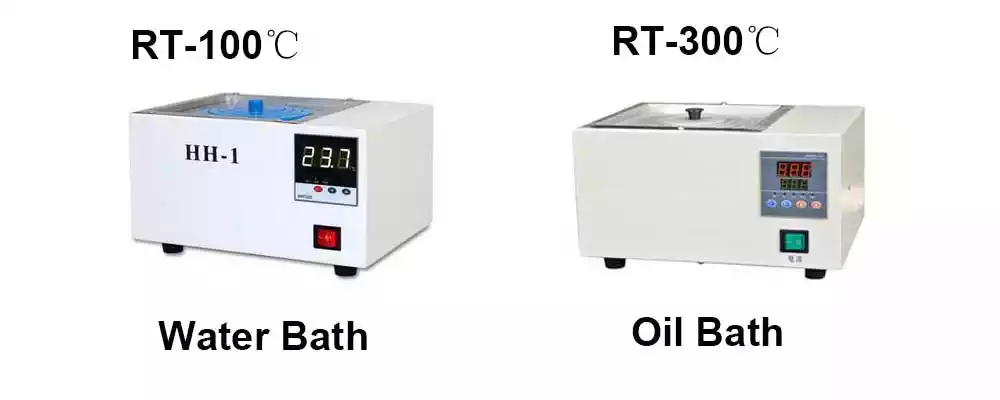What Is the Difference Between a Water Bath and an Oil Bath?

Both Water baths and oil baths adopt electric heating to maintain a constant temperature. They can be used for sample distillation, drying, concentration, impregnation, and other tests. They are widely used in petrochemical, metallurgy, medical and health, scientific research, environmental protection, and other fields. Are they different?
Yes, they have the following difference.
1. The heating medium is different: the water bath adopts water, while the oil bath adopts oil. Generally, we use oil such as methyl silicone oil or dimethyl silicone oil as the heating medium.
2. The temperature range is different: the temperature range of the water bath is room temperature to 100 ℃( 212 ℉), while the temperature range of the oil bath is room temperature to 300 ℃( 572 ℉).
3. The material and parts are different. Generally speaking, the highest working temperature of the oil bath is higher than the water bath, so all the components must have better heat resistance. The main differences are the following three aspects:
(1). Outer wall thickness: oil bath adopts thickened SUS 304 plate, while the ordinary SUS 304 plate is enough for a water bath.
(2). Different heating pipes: the heating pipes of the oil bath is thicker, so they have high power.
(3). Different temperature controllers: the oil bath controller has a broader control parameter.
4. Different prices: the oil bath is more expensive than the water bath because the cost is higher.
5. The oil bath can be used as a water bath, but the water bath cannot be used as an oil bath.
6. Comparison of how to use a water bath and an oil bath:
I. Usage of water bath
(1) Close the drain valve and fill the water bath with clean water (pure water) to an appropriate depth. Generally, it will be at most 2/3 of the capacity of the water bath.
(2) Connect the power supply and make sure the equipment is properly grounded.
(3) Turn on the equipment, and adjust the temperature control button to the set temperature.
Safety precaution:
(1) Remember that the water level must not be lower than the electric heating pipe. Otherwise, the electric heating pipe will be burnt out immediately.
(2) The inside of the controller shall not be affected by moisture to prevent electric leakage and damage to the controller.
(3) Pay attention to whether the water tank leaks at any time during use.
II. Usage of the oil bath
(1) When using the oil bath, you must first add oil to the oil bath and then connect it to the power supply. The digital temperature controller displays the actual measured temperature and adjusts the knob switch.
(2) Also, observe the reading to the required temperature value. When the set temperature value exceeds the oil temperature, the heating indicator light is on, indicating that the heater has begun to work.
(3) When the oil temperature reaches the required temperature, the constant temperature indicator light is on, and the heating indicator light is off.
(4) We shall note that the oil in the pot cannot make the electric heating tube leak out of the oil surface so as to avoid burning the electric heating tube and causing electric leakage.
Safety precaution:
(1) When injecting liquid into the oil bath, we shall control the water level to prevent excessive overflow. In summer, indoor and outdoor temperatures differ significantly. When the experimental temperature reaches 300 ℃, the liquid should be at about 80% of the volume.
(2) It is forbidden to use oil with high flammability and volatility. The oil used should be determined according to the temperature and experimental requirements. Glycerol is used for low temperatures, and cottonseed oil is used for high temperatures.
(3) Do not use the oil bath in places with poor ventilation. Keep away from fire sources and places prone to sparks to avoid fire.
(4) It is forbidden to burn in the air without oil, which will cause electric leakage, fire, and burn out the heating pipe. It is prohibited to operate with wet hands, which may cause electric leakage and shock. The power supply must use a grounding plug.
Click here to Visit Our Products.